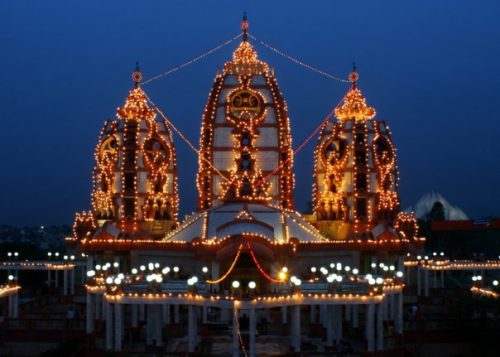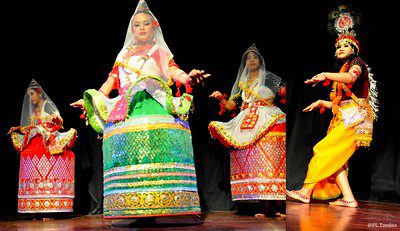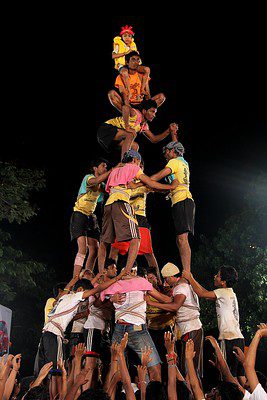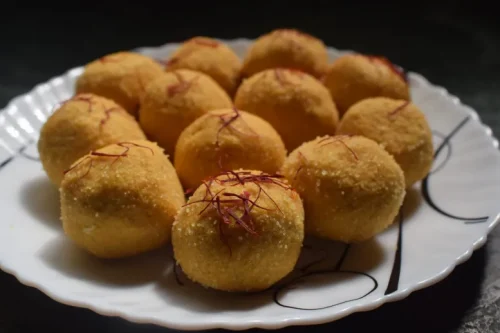Janmashtami, the auspicious festival in India that marks the birth of Lord Krishna, is celebrated with unmatched devotion and joy across India.

Steeped in ancient traditions and vibrant rituals, the festival unites devotees in their love and reverence for Lord Krishna, the eighth avatar of Lord Vishnu. More than just a religious occasion, it’s a cultural phenomenon that brings together diverse communities, each adding its unique flavour to the celebrations.
The Stories and Traditions of Janmashtami
What is Janmashtami? At the heart of the festival lies the enchanting story of Lord Krishna’s birth. Born in the prison cell of Mathura to Devaki and Vasudeva, Krishna’s arrival was foretold to end the tyranny of the evil king Kansa. The tale of how Vasudeva carried the infant Krishna across the turbulent Yamuna River to the safety of Gokul, where he was raised by Nanda and Yashoda, is a story cherished by millions. This narrative is brought to life during this festival through dramatic enactments known as Ras Leela and Krishna Leela, where performers recreate the divine moments of Krishna’s early life.
Fasting until midnight, the believed hour of Krishna’s birth is a common practice among devotees. This is followed by the ceremonial abhishek (bathing) of Krishna’s idol, which is then adorned with new clothes, jewellery, and flowers. Devotees sing hymns, chant prayers, and dance in joy, welcoming the divine child into their hearts and homes.
Rituals and Observances
How to celebrate Janmashtami is a commonly asked question. This festival’s rituals are deeply symbolic, representing the various facets of Lord Krishna’s life and teachings. The Abhishek ceremony, where the idol of Krishna is bathed in a mixture of milk, honey, and curd, symbolizes purity and devotion. The Chappan Bhog, a grand offering of 56 different food items, is made to Krishna, reflecting his fondness for sweets and dairy products.
Janmashtami fasting until midnight is another important ritual, signifying the devotee’s dedication and reverence. The breaking of the fast with a feast of traditional dishes, often including sweets like Makhan Misri (a mixture of butter and sugar), is a joyous occasion shared with family and friends.
In many regions, the reading of the Bhagavad Gita, Lord Krishna’s discourse to Arjuna on the battlefield of Kurukshetra, is an integral part of the celebrations. The Gita’s teachings on duty, righteousness, and devotion resonate deeply with devotees and are recited with great reverence.
Diverse Celebrations Across India
This festival’s significance and how it is celebrated vary widely across India, reflecting the country’s rich cultural diversity.
In Mathura and Vrindavan, where Krishna spent his childhood, the celebrations are particularly grand. Temples are decorated with flowers and lights, and the streets come alive with processions, music, and dance. The Jhulan Yatra, where a beautifully decorated swing is set up for Krishna’s idol, is a unique feature of Vrindavan’s celebrations. Devotees gather in large numbers to gently sway the swing, symbolizing their love and devotion.
In Maharashtra, the Dahi Handi festival is the highlight of this festival. Inspired by Krishna’s love for butter, teams of young men form human pyramids to break a pot filled with curd, suspended high above the ground. The event is competitive, lively, and often accompanied by spirited music and dancing. Mumbai, in particular, is famous for its Dahi Handi celebrations, which draw large crowds and even feature prizes for the tallest pyramids.
In Gujarat, the day is marked with the Mata ni Pachedi rituals, where devotees offer prayers at temples and homes, accompanied by traditional music and dance forms like Garba and Dandiya Raas. Krishna’s ras lila with Radha and the Gopis is beautifully depicted through these traditional dance forms, adding to the festive atmosphere.
In Odisha and West Bengal, this festival is observed with devotion and serenity. Devotees visit temples like the Jagannath Temple in Puri, where special rituals are performed. In Bengal, the day is also associated with fasting and prayers, culminating in a midnight celebration when Krishna is believed to have been born.
Majuli, the serene river island in Assam, holds a unique distinction as the only place where the Raas Leela of Lord Krishna is celebrated through elaborate theatrical performances by the devout. For centuries, the people of Majuli have honoured Lord Krishna by reenacting his Raas Leela. A highlight of the Raas Leela performances is the use of locally crafted masks, which bring to life various mythological characters and creatures. The festival spans four days, filled with cultural performances that beautifully blend local traditions with the timeless story of Krishna.
Holy Towns, Cities, and Celebrated Temples
Certain towns and cities hold special significance during this festival due to their historical and mythological associations with Lord Krishna.
Mathura, Krishna’s birthplace, is the epicentre of celebrations. The Krishna Janmabhoomi Temple, built on the site where Krishna is believed to have been born, becomes the focal point of devotion. The temple is adorned with lights and flowers, and thousands of devotees gather here to offer their prayers.
Vrindavan, where Krishna spent his childhood, is another holy town that witnesses grand celebrations. The Banke Bihari Temple and the ISKCON Temple in Vrindavan are famous for their elaborate rituals and processions. Devotees from all over the world visit these temples to experience the divine atmosphere that permeates the town.
Gokul, the sacred village in Uttar Pradesh. where Krishna spent his childhood, comes alive with vibrant celebrations. Devotees gather here to participate in the unique “Holi of Gokul,” where they drench each other in a paste made of milk and turmeric, symbolizing the playful and mischievous spirit of Krishna. The village also hosts the grand Nandotsav procession, where idols of Krishna and Radha are carried through the streets, accompanied by joyful chants and traditional music. The Chourasi Khambha, or 84 Pillars, is another must-see, depicting various episodes from Krishna’s childhood in intricate detail. Along the banks of the Yamuna, Brahmand Ghat offers a serene spot for reflection and devotion, steeped in the divine aura of Krishna’s presence.
Nathdwara, in Rajasthan, is where the idol of Shrinathji, a form of Krishna, is bathed in Panchamrit—a sacred mixture of five ingredients—and dressed in elegant garments. The following day, NandMahotsav takes centre stage with a grand procession. Nathdwara is also renowned for its stunning temples and natural beauty. A visit to the ancient temples of Eklingji and the picturesque town of Kankroli offers a deeper insight into the region’s rich cultural and historical heritage.
Dwarka in Gujarat, believed to be Krishna’s kingdom, is another significant site. The Dwarkadhish Temple in Dwarka is known for its celebrations, where special rituals like the Mangal Aarti are performed at dawn. The temple’s idol is bathed in milk and water, dressed in new clothes, and offered a variety of sweets.
Puri in Odisha, home to the Jagannath Temple, also holds special celebrations. The temple, dedicated to Krishna in his form as Jagannath, sees thousands of devotees flocking to witness the special rituals and offerings made to the deity on this day.
The Spiritual Significance of Raas Leela: A Dance of Divine Love
Raas Leela, the sacred dance drama of Lord Krishna and the Gopis, holds deep spiritual significance in Hindu tradition. It symbolizes the divine love and the soul’s yearning for union with the Supreme.

The Gopis, representing pure devotion, abandon all to dance with Krishna, who, in turn, multiplies himself to dance with each Gopi, embodying the omnipresence of the Divine. The circular dance reflects the cyclical nature of life, with Krishna at the center, symbolizing the eternal truth. Raas Leela teaches that true spiritual liberation comes from selfless devotion, surrender, and the realization of oneness with the Divine. Through its mystical performance, Raas Leela offers a direct connection with Krishna, awakening spiritual consciousness and celebrating the timeless bond between the soul and the Divine.
Dahi Handi: A Spirited Celebration of Lord Krishna’s Playful Legacy
Dahi Handi, a vibrant and thrilling celebration rooted in the tales of Lord Krishna’s mischievous childhood, is one of the most iconic events associated with this festival. This energetic festival, celebrated primarily in Maharashtra and parts of North India, brings to life the playful spirit of Krishna, fondly known as Makhan Chor (the butter thief).

The origins of Dahi Handi are steeped in the childhood stories of Krishna. According to legend, young Krishna had a fondness for butter and would often gather his friends to steal it from the homes of Gokul. To prevent Krishna from reaching the butter, the villagers would hang the pots of butter high up on the ceilings, but Krishna, with his ingenuity, would form human pyramids with his friends to reach and break the pots.This playful defiance of Krishna, symbolizing his joyous and carefree nature, is celebrated during Dahi Handi with great enthusiasm and camaraderie.
Dahi Handi is marked by the formation of human pyramids by teams of young men, known as Govindas. The objective is to reach and break a pot, or Handi, filled with curd, butter, and other dairy products, which is suspended high above the ground. The event is often competitive, with different teams vying to break the Handi first, while onlookers cheer them on with chants of “Govinda, Govinda!”
The atmosphere during Dahi Handi is electrifying, with music, dancing, and the thrill of the challenge creating an infectious energy. In cities like Mumbai, Dahi Handi has evolved into a major event, attracting large crowds and even offering substantial prizes for the winning teams.
Celebrated Foods and Sweets of Janmashtami
This festival is also a time to indulge in delicious foods and sweets that are traditionally associated with the festival. These offerings, known as bhog, are prepared with great devotion and are believed to be Krishna’s favourite treat.
Makhan Misri: As Krishna was famously fond of butter, Makhan Misri, a simple yet delightful mix of freshly churned butter and sugar, is a must-have during this festival. It is often offered to the deity and then distributed as prasad among devotees.
Panjiri: A staple during this festival, Panjiri is a nutritious sweet made from roasted whole wheat flour, ghee, sugar, and a variety of dry fruits. It is considered a highly auspicious offering and is believed to be a favourite of Krishna.
Gopalkala: Also known as the “food of the cowherds,” Gopalkala is a savoury dish made from flattened rice, yoghurt, cucumber, coconut, and spices. It is often prepared in Maharashtra and offered as naivedya during Dahi Handi celebrations.
Kheer: A traditional Indian dessert made from rice, milk, and sugar, Kheer is another popular offering during this festival. It is often flavored with cardamom and garnished with dry fruits, symbolizing the richness of devotion.

Ladoo: Various types of ladoos, including besan ladoo, coconut ladoo, and til ladoo, are prepared as offerings to Lord Krishna. These sweets are enjoyed by devotees and shared with family and friends during the festival.
Murukku: In South India, Murukku, a crispy, spiral-shaped snack made from rice flour and urad dal, is commonly prepared during this festival. It is offered to Krishna and later enjoyed as a festive treat.
A celebration of devotion, love, and the eternal teachings of Lord Krishna
This festival is a celebration of devotion, love, and the eternal teachings of Lord Krishna. From the sacred towns of Mathura and Vrindavan to the vibrant cities of Mumbai and Dwarka. This festival unites millions in their shared faith and reverence for Krishna. The diverse ways in which this festival is celebrated across India reflect the rich cultural tapestry of the country and the timeless appeal of Lord Krishna’s life and teachings.
FAQs about Janmashtami
Q: What is the significance of fasting?
A: Fasting is a way for devotees to purify themselves and demonstrate their devotion to Lord Krishna. The fast is broken at midnight, the believed time of Krishna’s birth, with a feast of traditional foods and sweets.
Q: Why is Dahi Handi celebrated?
A: Dahi Handi is celebrated to honour Krishna’s love for butter and curd. The event symbolizes the playful and mischievous nature of Krishna, who, along with his friends, would often steal butter from the households in Gokul.
Q: Which are the most famous temples to visit ?
A: Some of the most famous temples to visit during this festival include the Krishna Janmabhoomi Temple in Mathura, Banke Bihari Temple and ISKCON Temple in Vrindavan, Dwarkadhish Temple in Dwarka, and Jagannath Temple in Puri.
Q: What is the importance of Abhishek?
A: Abhishek is a ceremonial bathing of the idol of Krishna with milk, curd, honey, and other sacred ingredients. It symbolizes the purification of the mind and soul and is an essential part of rituals.
Q: Janmashtami dates in 2024
This year, the festival will be celebrated on Monday, August 26.
Q: How is Janmashtami celebrated in different parts of India?
A: This festival is celebrated in diverse ways across India. Mathura and Vrindavan involve elaborate processions and Ras Leela performances. In Maharashtra, the Dahi Handi festival is the highlight. In Gujarat, Garba and Dandiya Raas dances are performed, while in Odisha and West Bengal, the festival is observed with fasting and rituals.
Read more: Latest



